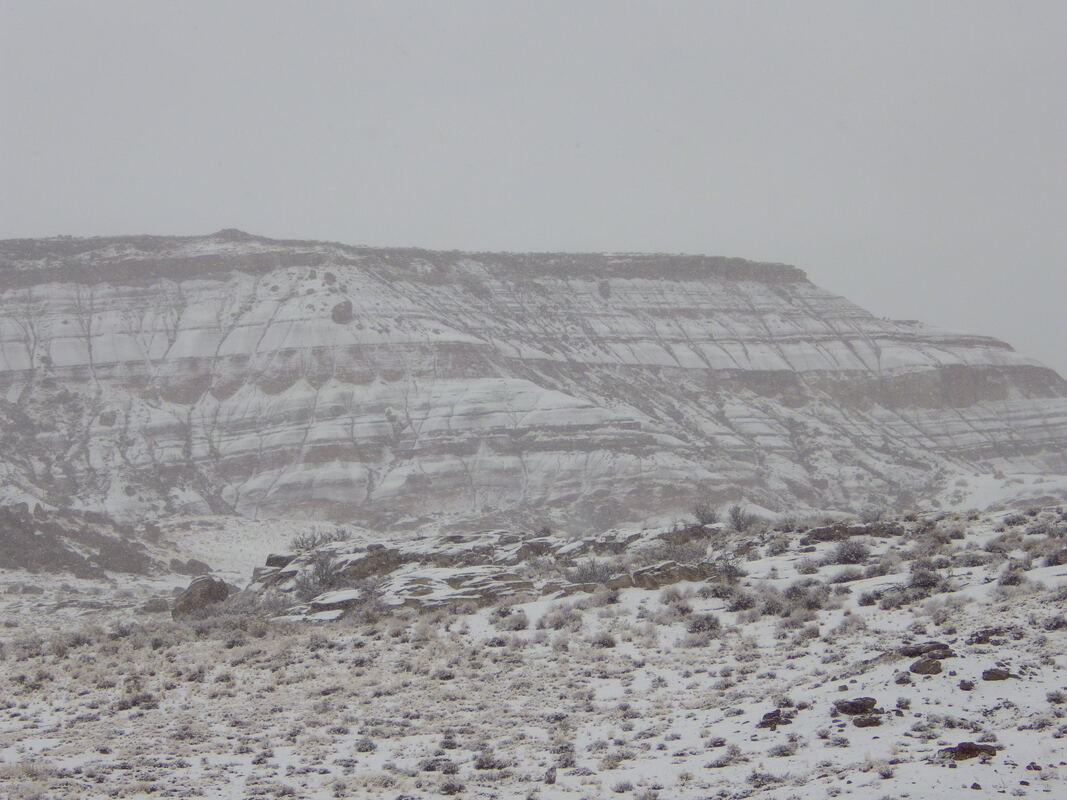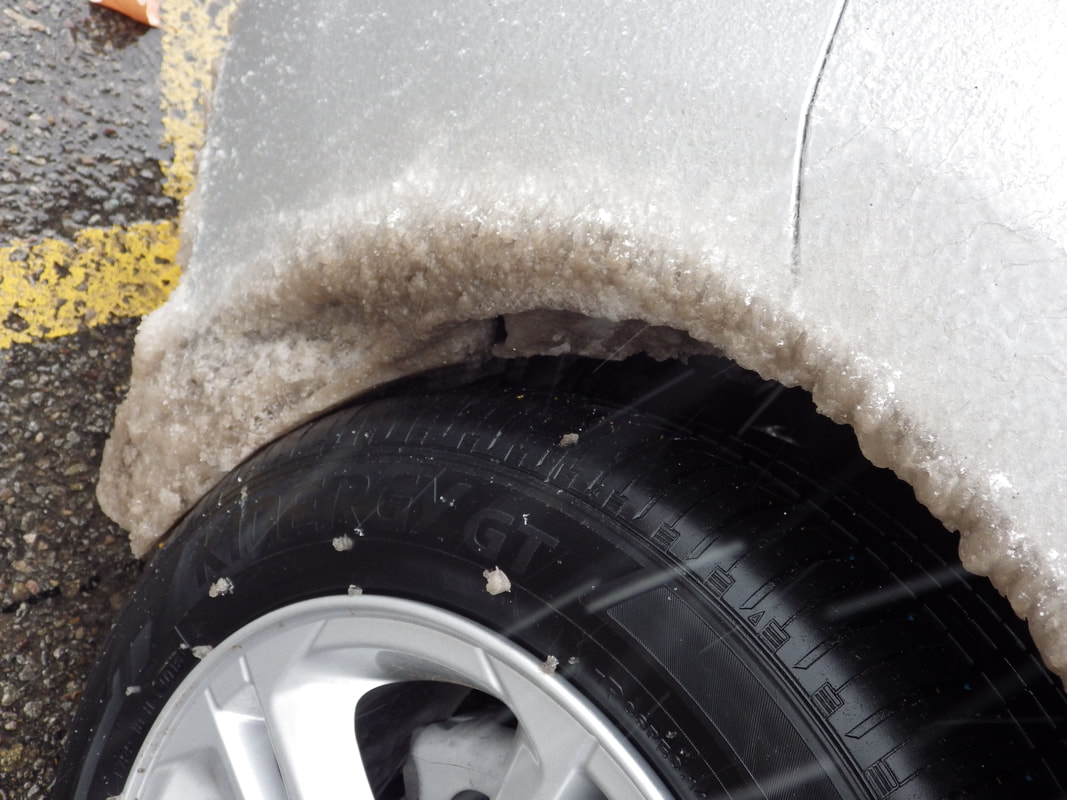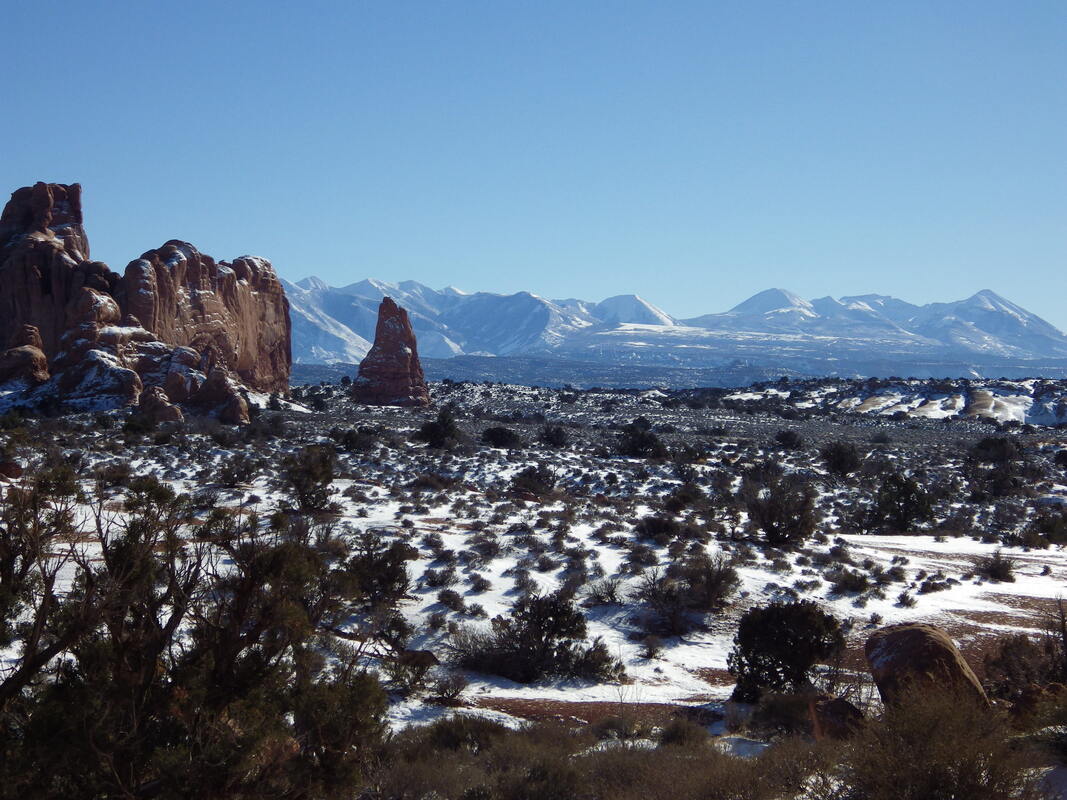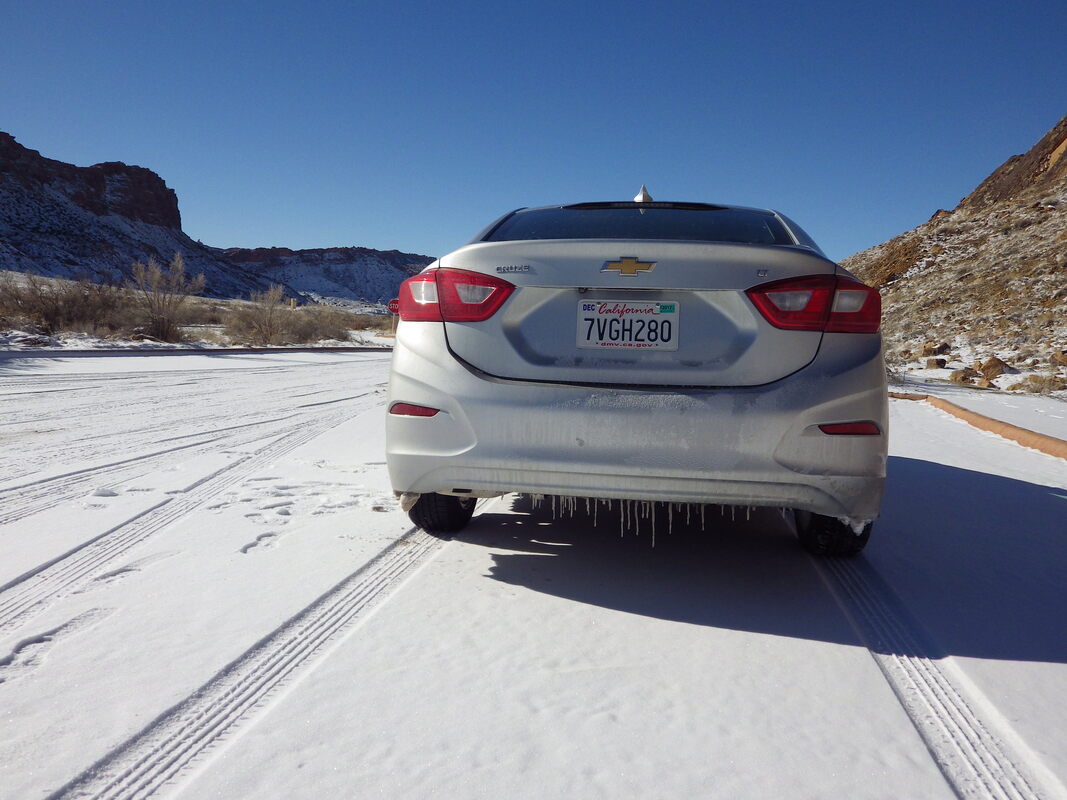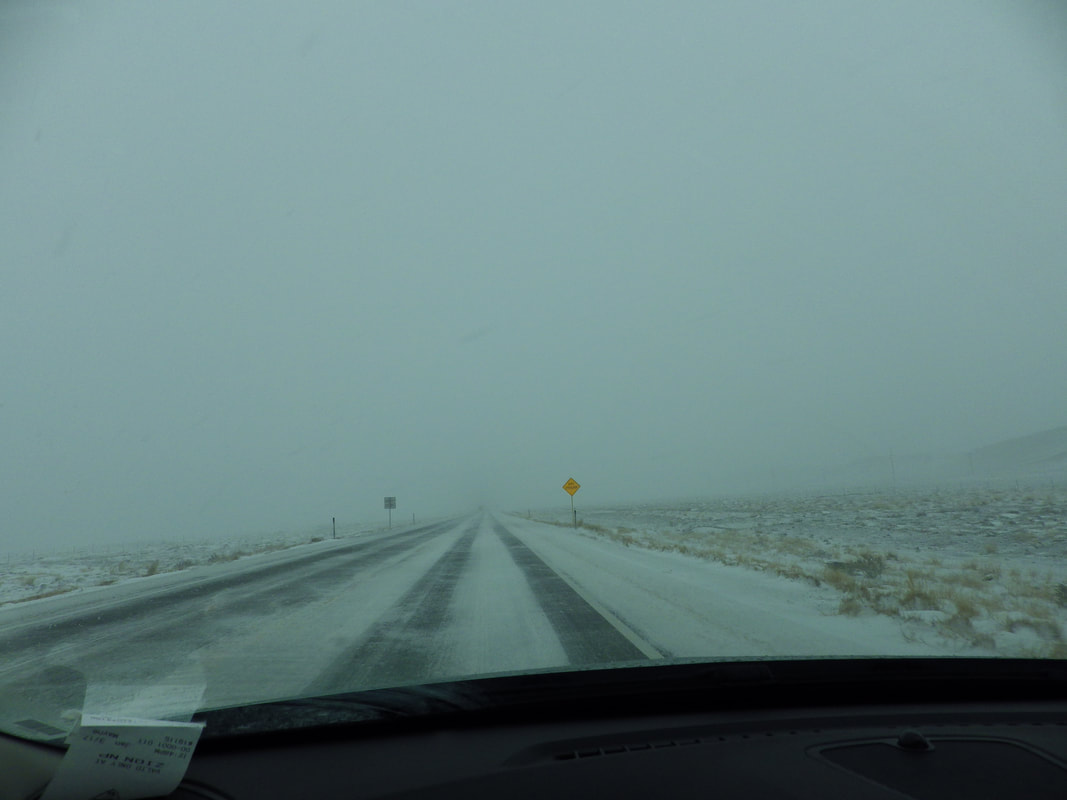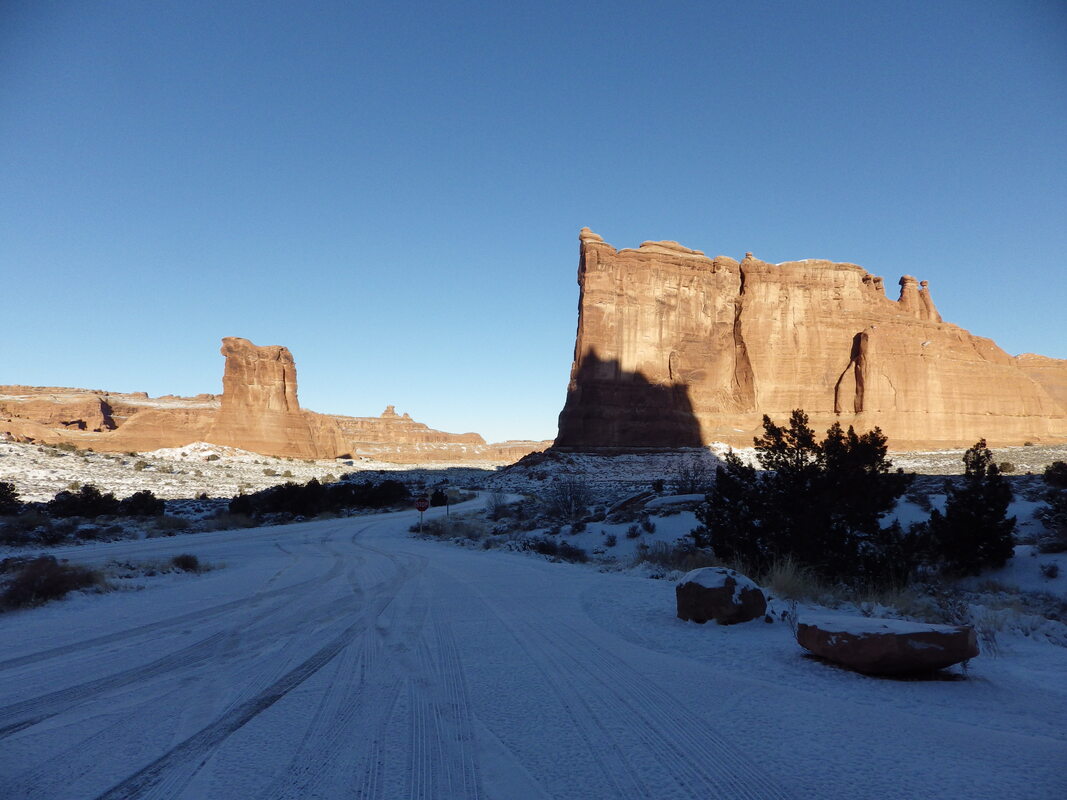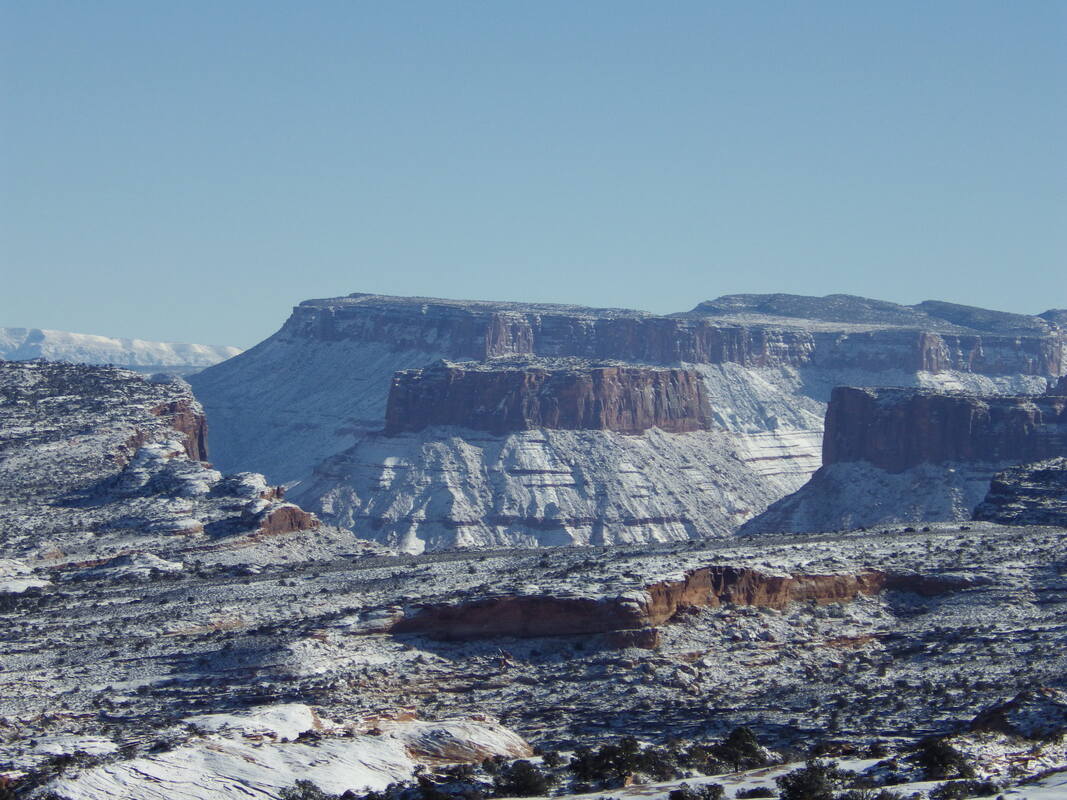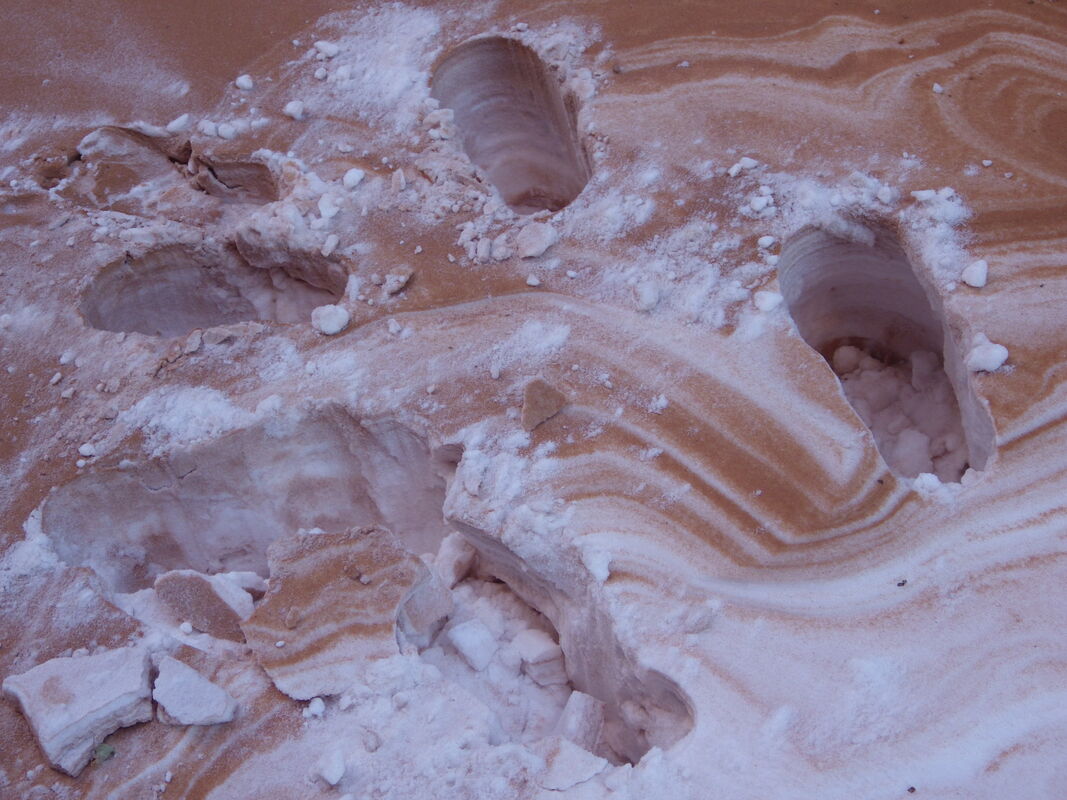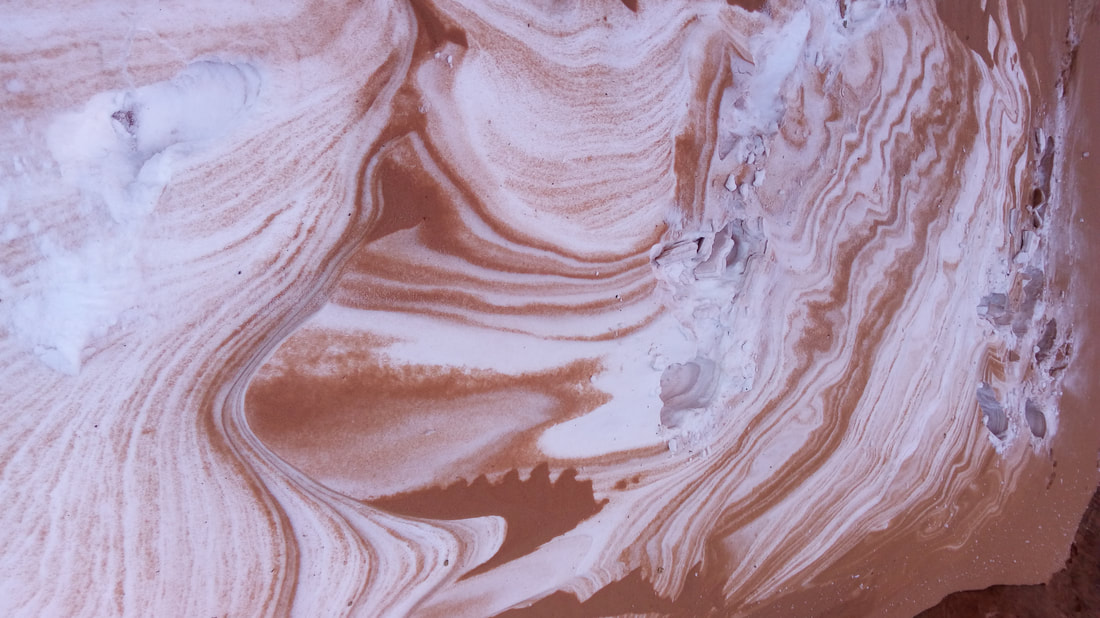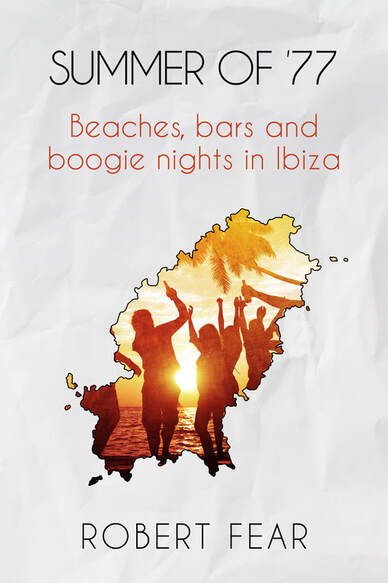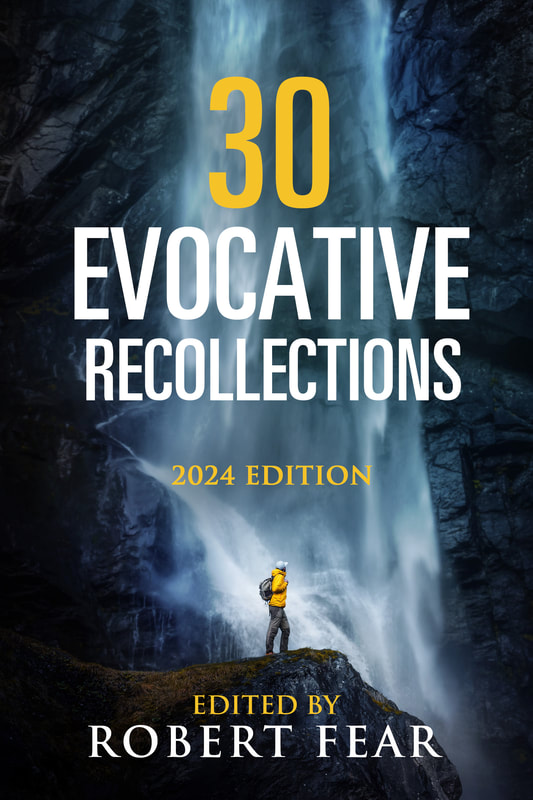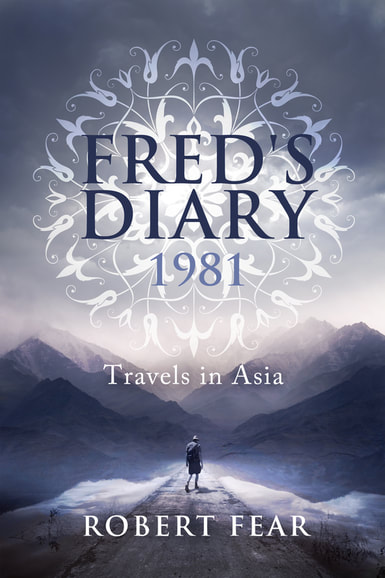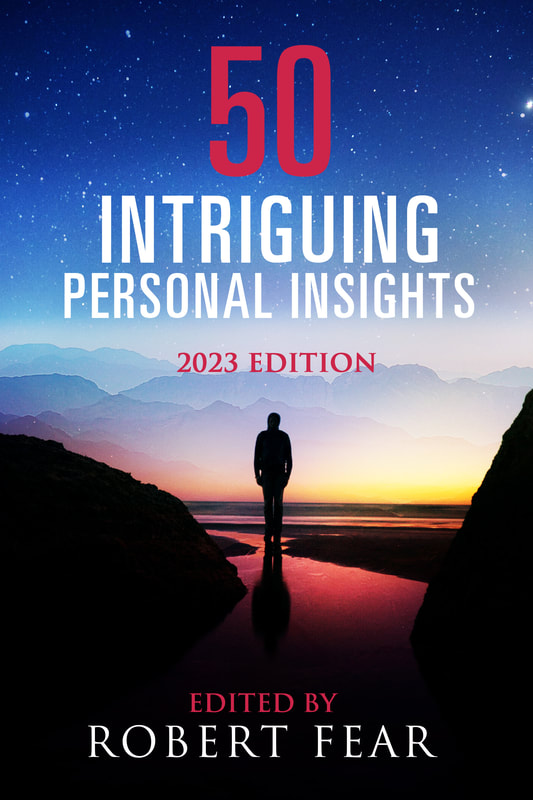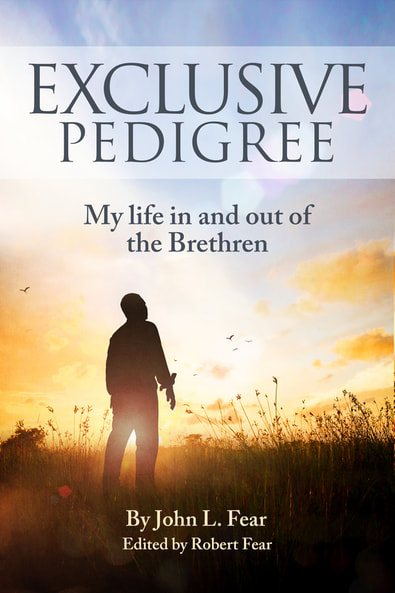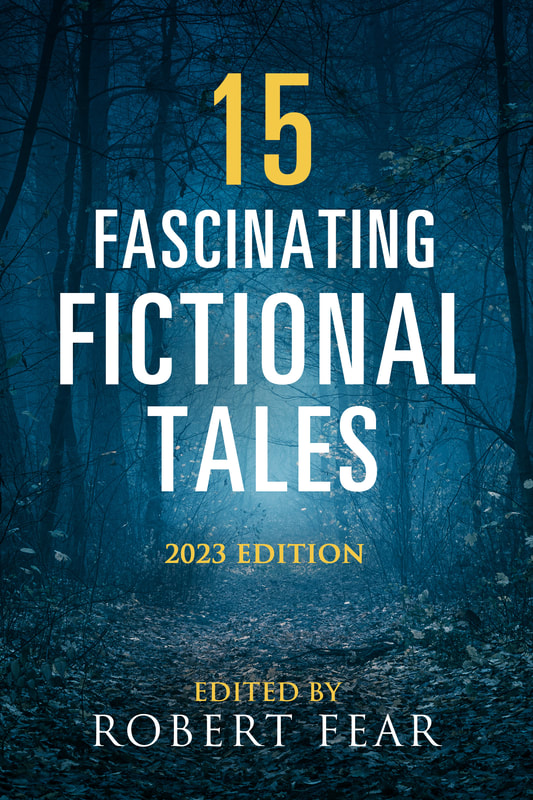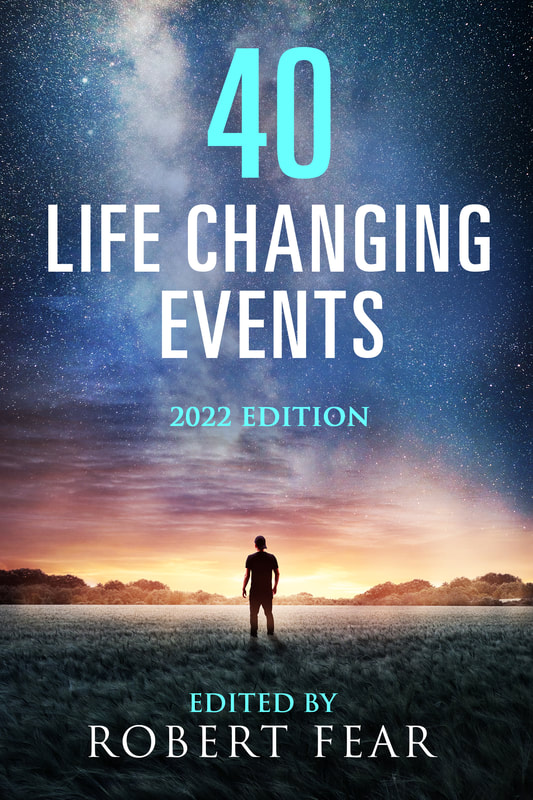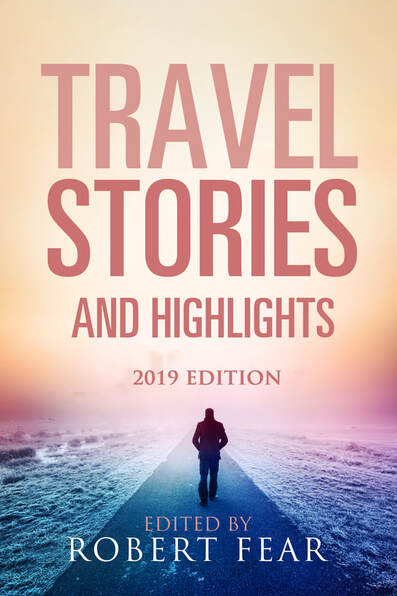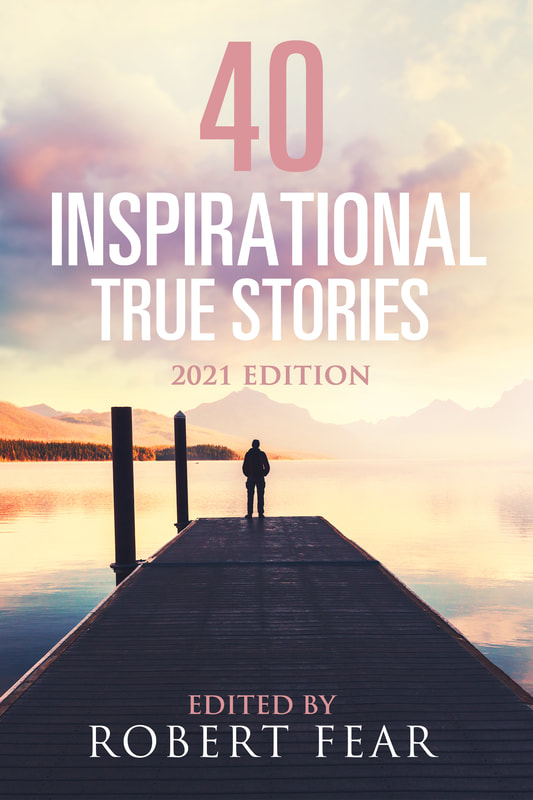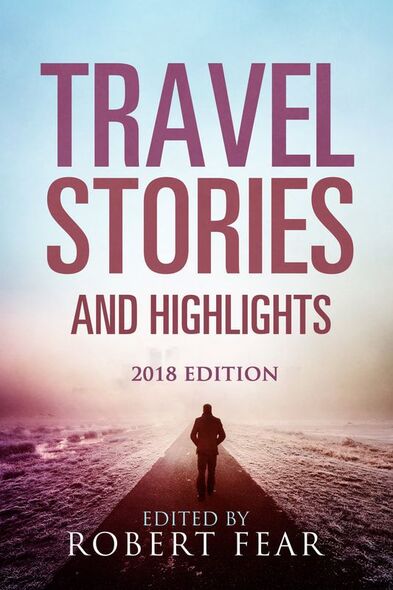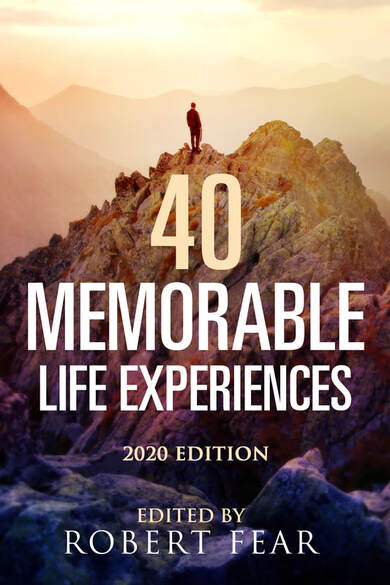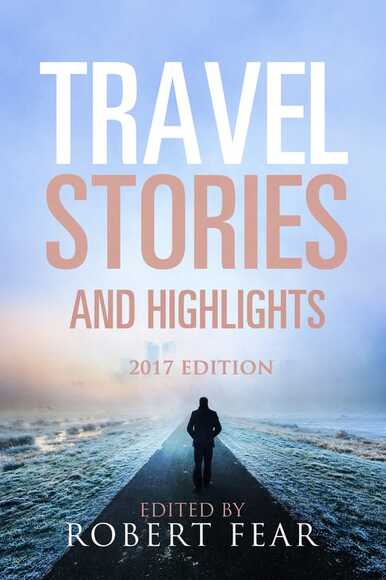Snow Ride by Carrie Riseley
After dark, I entered Capitol Reef National Park. I shouldn't say dark exactly because the twilight extends, so I could see the amazing red rock formations to my left, tantalising in the half light. I camped there that night, and in the morning continued along Utah State Highway 24. I drove through flat, red sandstone cliffs, one of which bears petroglyphs carved by the Ancestral Puebloans, who lived in that area from about 300 to 1300AD. No-one’s quite sure what happened to them, but the modern-day Hopi people are believed to be their descendants.
The red sandstone cliffs contracted toward the road, and it weaved through very close cliffs for a while, before emerging somewhere I never expected. It was like suddenly finding myself on the moon. But I’ve been to moonscapes before, and this was even more alien than that. Moonscapes are usually rocky and with one colour, but this had mountains and multiple… not colours, but shades. The predominant shade was grey; grey and dusty. The mountains were made of dust, too. They were giant piles; sometimes towers of dust that looked like it had been petrified by some other-worldly force. It was mad. The road went into it so suddenly, and then it emerged in a rural area again, but the dusty mountains were still there at the edges of the fields. I saw a sign saying it was something called the “Lunar Mesa”. I’d also heard the term "badlands" in different places, and I wondered if this was one of them. If it was, I finally understand the term – previously I’d thought it was far too pessimistic!
A little way after that the dusty mountains turned stripy again, and it started snowing. The 24 hit a T junction at Hanksville, a town which also seemed other-worldly. Many of the towns in that area have a high concentration of stained timber buildings – because they’re frontier towns, I suppose. I’m not sure where the “wild west” is exactly, but this town seemed to be part of it. It mostly seemed to be one colour: sort of brown and dusty. The buildings were short and spaced well apart, so I could see the badlands all around. The only sign of life was the Christmas decorations.
I needed coffee and a pee, so I stopped at a gas station. It was at this point that my impression of Hanksville in my mind morphed into my impression of Coober Pedy, the Australian outback town where a lot of people live underground to escape the heat. This gas station was inside a cave in an outcrop of red sandstone, so I felt like I was going underground. Hanksville is also in the middle of the desert, and it’s a little lunar-looking and creepy. Very like Coober Pedy. Except for the fact that it was snowing.
After getting my coffee in the cave gas station, I asked the lady behind the counter how far it was to Moab. She said it was 110 miles, which was further than I’d thought. Then she mentioned the snow, and brought up a weather map on her computer which showed a storm was setting in. I’d heard the forecast of snow on the radio that morning and thought, I’d better get accommodation inside tonight. Snow wouldn’t be good for camping. That was all I thought about it at that point…
The lady in the cave gas station showed me the weather map and told me what roads I needed to take to get to Moab. “In between here and there, there’s Green River,” she said. “If you can’t make it to Moab, you’ll find somewhere to stay there.” The fact that she was talking, at 12:20 in the afternoon, about the possibility of me not making it to Moab should have rung alarm bells in my head. But it didn’t. So I happily drove off into the desert along Highway 24.
The 24 from Hanksville to the I70 is a long, straight road. That was a very lucky thing. If what was about to happen had happened the previous day, when I was on the super-windy-with-steep-drop-offs Scenic Byway 12, I don’t want to think about what might have happened.
I thought the desert in the snow was just lovely. There were more red sandstone outcrops just outside of town, and I stopped and took photos and happy selfies of them. Then the scenery became flat desert with little bobbly grass plants, and it was white instead of red; snowy instead of sandy. I thought that was just incredible, and I stopped to take photos of it too.
I did hurry myself along a little - I didn’t have a lunch break. I had a loaf of sourdough bread on the passenger seat and two green apples in the console, and I snacked on them while driving.
It kept snowing; in fact it got heavier. Twenty or thirty minutes along this lonely desert road, the white at the sides of the road suddenly spread onto the road. In some situations, my boundless optimism can make me incredibly naive and unobservant. I had had no idea that this was going to happen. I guess I thought it’d take a lot more snow than was currently falling for it to settle? Or that it only settled at night when it was cold? But it was cold. I didn’t understand the temperatures in the weather forecast, but they were all below 30 Fahrenheit, which means below zero Centigrade. Zero is the temperature when frozen things stay frozen. Snow settles.
So snow appeared on the road, and I just had to keep driving. The road became fully white, and visibility diminished significantly. I followed another car for a bit, liking its lights and the fact that it wasn’t sliding. It cleared up a bit, then got worse again. I got used to it after a while and started stopping to take photos again. Driving through the desert in a snowstorm, I thought. This will become a good story.
Eventually I came to the end of State Highway 24 and turned onto the I70. “I” stands for Interstate. That’s a massive freeway. It has one of the highest speed limits in the country: 80 miles per hour (128.75km). Wow, I thought. This could be the fastest I’ve ever legally driven. But I’m going to do 40mi/h instead.
An interstate freeway is usually flat, straight and quick. They can be scary because all the traffic goes really fast, and there’s lots of it, including lots of trucks. I got onto the interstate at about 1:45pm. By that stage, the snow storm had fully set in. Everything was white, except for part of the right lane where everybody had been driving. Part of it. This lane was wet, and all the cars and trucks that overtook me in the snow-covered left lane sprayed my windscreen with water and snow. It was scary. I was still a long way from Moab, and the weather seemed to be getting worse, not better.
The exit for Green River appeared. I decided to get off the freeway and ask for help, because I didn’t have a clue how to drive in the snow and everything was becoming increasingly alarming. There was a sign for a tourist information centre, so I figured I’d go there, but as soon as I got off the exit ramp, things got more alarming still. The streets in Green River were completely white. I hadn’t thought it possible to be more white than Highway 24 or the left lane of the freeway, but oh boy, it was.
On this white road, I drove into a town I had never seen before. Even if I had, it would not have been recognisable because of all the white. Like most American towns, it was long. This was a problem, because I didn’t want to drive on the completely white road any longer than I had to. I could see no signs for the information centre. To my right, I saw a small one-storey building with a sign that said, “Utah Highway Patrol”. I pulled into the snow of their parking lot. This was totally the sort of situation where you can ask the police for help.
I was still calm. I must have been, because when I got out of the car I took photos of its tracks in the snow, and mine, and Green River’s white main street. I made the first footprints in the snow leading to the door of the police station. This wasn’t a good sign, because the door was locked. There was no-one there.
Fortunately, next door to the highway patrol building was another small one-storey building of the same design, with a sign that said, “City Hall”. I’d heard of City Halls - that’s what Americans call their local council chambers. I work for my local council back home, in customer service. They’ll help me, I thought.
It really was a tiny building. I stepped into the reception area, in which there were three desks with three ladies sitting behind them. I opened with, “Sorry to bother you. I’m from Australia and I’ve never driven in the snow before in my life…”
They were very helpful. They checked a weather site, which showed that at that time Moab wasn’t as bad as Green River but the storm was heading that way and worsening. They tried to bring up webcam images of the roads but couldn’t, so one of the ladies rang her sister, who lives in Moab. The sister was very helpful, too - she rang back a few minutes later with more information about snow ploughs.
They seemed to think that I would be OK if I drove slowly, but one of them did say, “It seems like if you’re gonna go, you’d better go now.” I agreed with this option as it was only 2pm, and what was I gonna do in Green River all afternoon if I stopped now? I had to get to Moab so I could go sightseeing tomorrow! I had plenty of time to get there if I just went slow.
Three very reassuring things the council customer service officers told me were:
● In good weather, Moab is only about 50 minutes’ drive
● In snow, pump the brakes: don’t ever push them hard because you will slide
● Snow ploughs are clearing the roads
I decided to go for it. I asked the helpful council officers to wish me luck, and I drove back out onto the snowy roads.
Now, let me make one thing clear. I am a painfully careful driver. I would not have been doing this if I hadn’t been sure that I could. I certainly wouldn’t have been doing it if my car had been sliding at all. Three very important pieces of information enabled me to make that snowy drive:
1. I’d cycled on snow in Japan, both fresh snow and snow that was a couple of days old. The snow that was a couple of days old had become icy - my tyres slid all over the place. But the fresh snow was absolutely fine - the tyres cut right through it.
2. I used to know a truckie who told me that the worst thing you can do when a truck is passing you is brake. If you do, air pressure might suck you towards the truck. What you should do instead is accelerate, so your tyres grip the road.
3. The advice the council ladies gave me about braking. If that was all they thought I needed to know, I was happy to trust them.
The bit about the trucks was very necessary. I got overtaken so many times, and there were a lot of trucks on the interstate and on Highway 191, which was a highway with no divider and only periodic overtaking lanes. I couldn’t see a thing out to the sides because the road had been swallowed by the weather, but I assume it was flat and deserty because it was windy! So I really appreciated knowing how to make my tyres grip the road when trucks passed me.
Did you know that after and during snow, vehicles drop ice onto the road at random? I found this out when a truck overtook me and then as it was merging back in front of me, it dropped a bunch of rocks onto the road. The largest rock bounced towards my car and hit it. I was outraged that a truck was dropping its load of rocks, and I wanted to report it but I didn’t know who to. Then I realised that they weren’t rocks: they were chunks of ice. When you drive, whatever you are driving over gets thrown up into the car’s wheel arches – dust if it’s dust, mud if it’s mud, snow if it’s snow. And fresh snow sticks. I had to kneel on the snow a couple of times the next day to deal with this very problem – attempting to clear ice from under my own wheel arches. If I didn’t brush the snow off my trousers when I stood up again, it would just stay there. It wouldn't melt or seep in, because the temperature was still well below freezing. It would just sit on the trousers, stuck to them.
Well, when you’re driving through snow, quite a lot of it gets stuck inside the wheel arches, and anywhere else it can stick under the car. It then melts with the heat of the engine and re-freezes with the cold air, making ice rocks, which fall out whenever and wherever and go all over the road. This kept happening for days afterwards. Sometimes I’d see the ice falling out of a car, and other times I’d just see ice rocks sitting in the middle of the road for goodness how long.
I made it to Moab. It took me about 2 hours from Green River, about 3 ½ hours total of driving in heavy snow. Moab is also very long and spread out. I had the address of a hostel, but all the street signs were covered in snow. Fortunately, I found Wi-Fi at a laundromat, but even after checking on Google Maps, I had to drive up and down a couple of times because the signs weren’t visible. I finally arrived at the Lazy Lizard Hostel, where the helpful receptionist offered me a dorm bed for $11 or a private room for $20. Amazing. Full hostel facilities too. Excellent place.
The forecast for the next day was clear, but cold. That's fine, I thought, as long as I get to see some stuff. I got up early so I could try to see as much as possible. I went to Arches National Park, arriving a little after 8am. Now here’s something that unobservant, hyper-optimistic me failed to realise. I had been told by the ladies at Green River that the snow wouldn’t melt for a few days, but it didn’t occur to me that that meant the snow on the roads wouldn’t be gone either. Snow ploughs had been out, in the national park too, but they can’t wipe the roads clean, so they were all still pearly white.
I realised it when I got onto them, obviously, but I’d got up early and I wanted to see stuff, dammit! And driving on snow wasn’t nearly as bad as I’d thought. My car hadn’t slid at all. It was fresh snow, you see. Now it was day old snow, but the temperature hadn’t risen above freezing at any point and nor had the sun come out, so it was like fresh snow still. I decided I’d be fine because I knew how to drive on snow now. I just drove at 25mi/h all day.
It was so beautiful. Red rock and white snow. And arches! The arches have happened because there’s a layer of salt from an old sea floor that the sandstone sits on. It’s been uplifted over time, and the softer layers have bent, but when sandstone tries to do that it just splits in arch patterns. It’s beautiful. They start as holes, and then over time with erosion they become arches. Then, over more time, the arches fall and the geology timeline continues.
I was having a lovely time driving through the snow-covered red rock desert national park. I wasn’t having any problem with the snow on the road, because it wasn’t slippy at all. The only problem I discovered was that I could hear scraping when I went around corners. I figured out what it was. You know all that snow that collects under the wheel arches? It turns out you need to clear it out whenever you can. If you don’t, it becomes ice, and the ice scrapes on your tyres. You hear this horrible noise whenever you have to turn the wheel, and you can’t really go around tight corners at all. If one of my tyres burst it would be quite serious, particularly for my wallet, because I had chosen not to buy the upgraded tyre insurance for my hire car.
I guess tyres are designed to be pretty tough, but never having had this experience before, I had no idea what to expect. I kept expecting to hear a horrible, and expensive, popping sound. I started taking corners really wide and parking at 45 instead of 90 degree angles. The national park wasn’t busy yet, so that was OK. Because I hadn’t discovered the problem until I was already at the top of the plateau, there was nothing I could do except proceed to my first destination and park at a special angle so the ice was in the sun. There were two short walks at that place. I did one, came back and used a knife to hack away as much of the ice as I could from the side of the car that was in the sun. Then I re-parked the car the opposite way around so the other side was in the sun, and I did the other walk.
All this clearing of ice was very tiring, and I cut my finger and enraged my RSI, but it seemed to help. This lessened my worry and greatly increased my ability to turn corners. And the fact that that was my only problem in the snow was good.
I saw several more arches, and absolutely amazing views of the landscape around. Canyons and other mountains: stripy and snow-capped, respectively. My favourite part was a very short walk to Sand Dune Arch, which was in an interesting location in a small chasm between some long, tall rocks. The chasm was a wind tunnel, which made it *insert expletive here* FREEZING, but it also created sand dunes.
Do you know that sand dunes are moving and shifting all the time with the breeze? And do you also know that snow falls in drifts: a bit and then a bit more? What I hadn’t known, but had learned the previous day when I’d seen it blowing across the road surface, is that snow gets blown about a lot too, even after it’s settled, because it’s so light.
Can you imagine what would happen in a place where both snow and sand are blowing about at the same time? It marbled. Lining the path were banks of marbled snow and red sand – lines on lines on lines of each; across and up and down; over and under, in all sorts of mystical shapes. Snow, sand, snow, sand, snow, sand – or was it sand, snow, sand, snow, sand snow? Both, I think…
I didn't jump into the snow drift because I didn’t want to destroy that incredible image, but someone else had, and when I looked down into the footprints, I could see the layers. A layer of snow had fallen, and then a layer of sand had shifted, and then another, and another, alternating one and then the other – evenly, incredibly enough. It was spellbinding. I got really cold taking a million photos of that!
I moved slowly that day, both in the car and on foot, because I didn’t think it was a good idea to rush anywhere. I knew if I finished seeing the arches early I’d either do the long walk at the end of the road, which it said had rock surfaces and scrambling, plus ice = falling = danger to my person. Or I’d try to drive to Dead Horse Point, where the roads would also be icy, plus end of day rush = danger to my car (and potentially my person). So I just did everything really slowly. I’d been hearing on the radio that the storm had now moved north, to areas which get more and deeper snow, and east to areas which don’t. People there didn’t know what to do, so the storm was wreaking a lot of havoc. I heard one mayor telling his citizens that they should aim to be home and off the roads by 4pm. I thought that was good advice I should take, so I started heading back a little after 3.
Nothing progresses very fast when you’re driving 25mi/h tho. And I did stop at another lookout place and stayed a while because it was amazing, looking over tall rocks and down off the plateau toward canyons, desert and snow. I was still quite worried about the ice in the wheel arches and wanted to let it melt a little in the remaining sun. Guess what else I didn’t know? When you are clearing snow and ice from your wheel arches, you should not only clear the bits at the sides which are interfering with your wheels; you should also clear the bits at the top. Guess what happens in the daytime when you have ice at the tops of your wheel arches? It melts and runs down, gets stopped by the wheel and re-freezes right up against it! There was a section on one of the back wheels in particular that was right up against the wheel. I could hear it grating ominously, but there was nothing I could do except drive, very slowly and carefully, back down the mountain.
I was about two thirds of the way out of the park, concentrating hard on the road because some bits of snow had melted and I didn’t want to encounter ice, when a driver going in the opposite direction flagged me down. I thought I’d better stop, because he might want to tell me about a hazard on the road up ahead.
It turned out the hazard was behind me. An American ginormousobile truck, to be precise. Something called a Ford F350. Slammed right into me. The driver said it was because he’d slid on ice. Maybe he slammed the brakes instead of pumping them. I’d thought he was following me at a safe distance, and he’d probably thought that too, but it turns out a safe distance in the snow needs to be a lot farther.
The driver who had flagged me down was the problem. He flagged down a moving vehicle from a moving vehicle at a T intersection. It was just because he wanted to ask me the condition of the road. He didn’t need to tell me anything: he just wanted me to tell him what the road was like in the direction I had come from.
I asked the guy who hit me what the procedure was for car accidents in the US, i.e. whether we needed to call the police, and he said no because no-one was injured. I just wanted to go back to my warm hostel and ring the car hire company, so I did that. The car was perfectly drivable, but only because I’d been going at 25mi/h and so the truck had been forced to do the same. If he’d been going faster, my little Chevrolet hire car would have been a write-off.
After wrestling with the hire company’s phone robot for a few minutes, I found a number that had a real person answering. It was the roadside assist number. They told me they would send me a new car, but not until I gave them a police report number. I told them the car was perfectly drivable, but they said they had to send me a new one. I guess they had to follow up on the insurance and get it fixed right away. So I called the police, and a local sheriff came out. “Why didn’t you report this to the national park?” he said.
“I didn't know I had to…” I replied. I thought reporting it to the police was a fair enough thing, so I was doing so. He did think that was fair enough, but he had to do some investigating. He retired to his car and made some phone calls. When he emerged, he informed me that he had absolutely no jurisdiction over the national park, so he couldn’t write a police report for me. I had to report it to the national park police.
The national park police?
This is how I found out that the US has many layers of multi-faceted police bureaucracy. I knew that they had city-based instead of state-based police, and I had no idea how that worked. Well, they just have very many jurisdictions, and this probably results in the wrong police being called on many occasions. Later in my travels, my hosts in Albuquerque told me the national park police service was established because the mafia was making drugs in Yosemite! They also said there’s different police for amenities services/land; that there’s highway police run by the state; and that sometimes there are county and city police in the same area whose jurisdictions overlap. That sounds mighty confusing.
Anyway, the national park offices were well and truly closed by that stage, so the sheriff gave me their number and I called the next morning. This involved a bit of phone wrestling again, but eventually I got through to an Arches National Park police officer called Alissa. She told me that I would have to go to the visitor centre and fill in a form declaring what happened.
To drive the car again, I had to figure out a way to tie the boot down. I didn’t do a good inspection at the time of the accident because I thought it was just a superficial injury to the bumper bar, but when I got back to the hostel and popped the boot, it took a bit to open. I had to pull it, and then it wouldn’t shut again. It also became clear that the frame of the car had been impacted where the boot latch mechanism is, as some broken and bent bits became visible there.
The look on the face of the receptionist at my hostel when I told him my boot was stuck up in the air established that I would need to use the American word. Up until that point, I had never used the word “trunk” to refer to anything other than a growth on an elephant or an elephant seal. Over that 24 hour period, I had to use it a lot. “The trunk’s stuck up in the air,” “I can’t close the trunk,” “I have to tie the trunk down.” It’s a good job I’m good at languages.
So after tying the trunk down, poorly, and reversing with the reverse camera pointing way up in the air, I drove the injured Chevy back to Arches National Park. Fortunately, the visitor centre is not up the hill with the snow on it. Alissa and the other staff there were very helpful. I gave all my details (driver’s licence, international licence etc) and filled out the police report form, and Alissa crossed all the i’s and dotted all the t’s and gave me a police report number. She told me that mine had been one of 8 car accidents in Arches National Park the previous day. Another guy in my hostel was stuck there because he’d crashed his car in Moab by slamming on the brakes and sliding. Elsewhere in the country, several people died.
I had assumed that because people were driving on the roads, and driving faster than me, that it mustn’t have been that bad. If this had happened in Australia, the entire national park would have been closed, but no such thing here. It seems to be a Land of the Free thing. Americans firmly believe in their own freedoms, so they take personal responsibility for their choices. While I was in the visitor centre, I overheard several conversations between tourists and park rangers. The park rangers kept saying, “The road is pretty icy, so personally I wouldn’t drive up there today, but it’s up to you.” It’s the Land of the Free.
I phoned the car rental company and gave them my police report number, and they said they’d send me a new car in three hours. I bemoaned the loss of another sightseeing day, but the company gave me amazing service, driving the new car from their nearest depot, which was in the next state, and delivering it to me at my accommodation. It was a Volkswagen Tiguan. Back home I’d feel uncomfortable driving a vehicle of that size, but in America, compared to all the ginormousobiles, it doesn’t look big at all. I was actually relieved that it was bigger than the Chevy, given all the snow, gravel scenic pull-outs and national parks. I had thought it was appropriate to be driving an American car on my American road trip, but give me a European car and I’ll be happy as larry. So me and the Tiguan drove off into the sunset, heading toward Monument Valley, Arizona…
Marbelling of snow and sand
